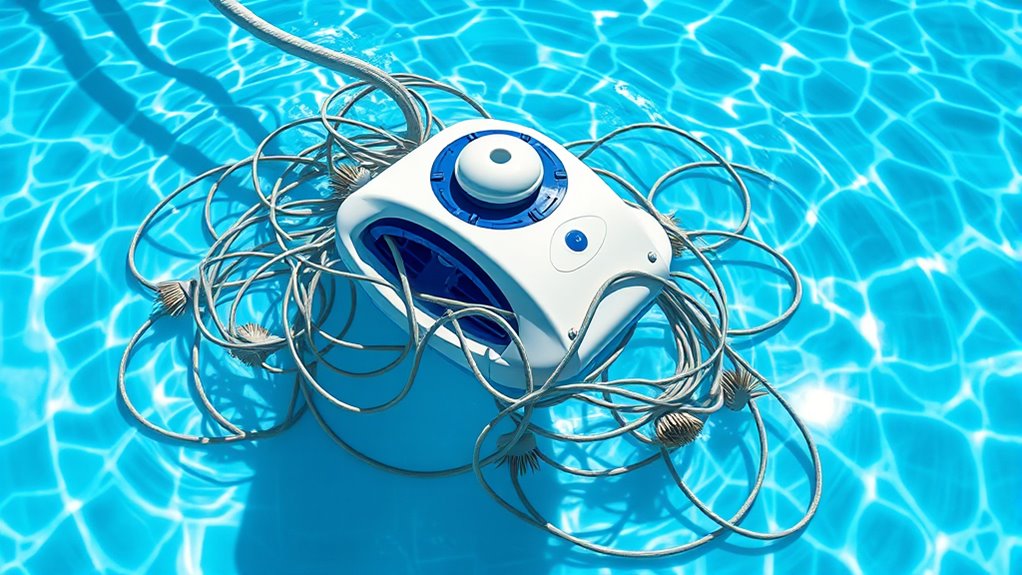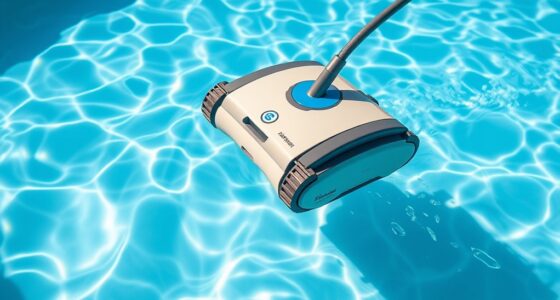Owning a suction pool cleaner involves more than just the initial purchase, with costs adding up from installation, energy use, and ongoing maintenance. You’ll need to budget for repairs, part replacements, and potential unexpected expenses that can increase overall costs. While upfront prices vary, long-term savings come from choosing energy-efficient models and maintaining the equipment properly. To get a clearer picture of your total investment, explore the details you haven’t considered yet.
Key Takeaways
- Initial purchase and installation costs vary from $200 to over $1,000, depending on features and setup complexity.
- Energy-efficient models reduce long-term operational expenses through lower power consumption.
- Regular maintenance and part replacements are necessary to prevent costly repairs and extend cleaner lifespan.
- Hidden costs include unexpected repairs, part price fluctuations, and compatibility issues.
- Long-term savings are achievable with durable, low-maintenance units and proper upkeep practices.
Initial Purchase and Installation Expenses
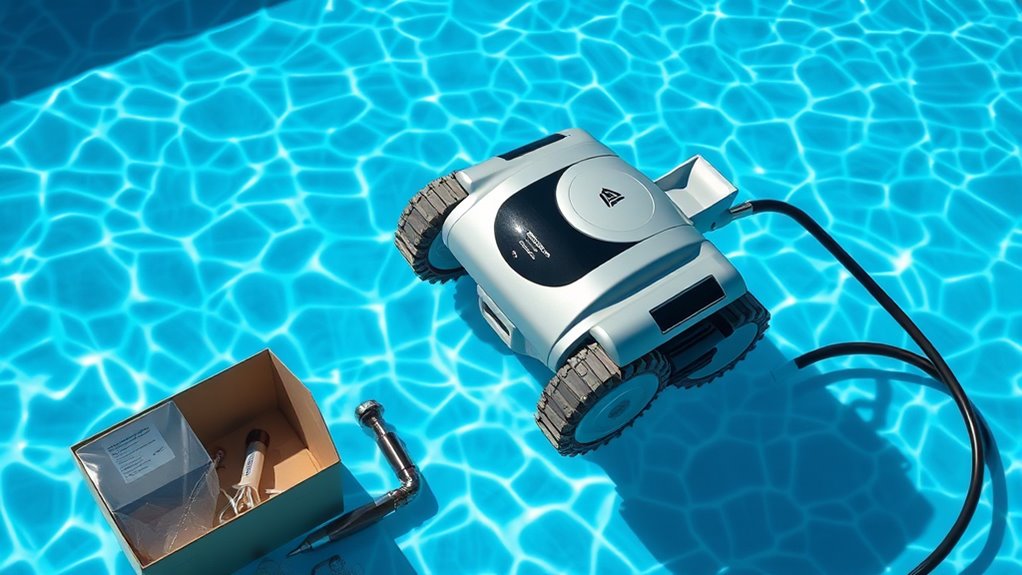
Are you wondering how much you’ll need to spend upfront on a suction pool cleaner? Your initial investment includes the cost of the cleaner itself and the pool installation. Basic models can start around $200 to $500, while more advanced units may reach $1,000 or more. Keep in mind, the installation process might add to your upfront costs, especially if your pool requires modifications or special setup. Some models come with accessories or extra features that increase the initial purchase price. When budgeting, consider these expenses as part of your overall pool setup. Additionally, understanding the initial purchase and installation expenses can help you make an informed decision about the best pool cleaning solution for your needs. It’s also important to evaluate the long-term maintenance costs associated with different models, as these can significantly impact your overall investment. Conducting a thorough assessment of the costs involved can help prevent unexpected expenses and ensure you select a model that fits your budget. Although the initial investment might seem significant, a good-quality suction pool cleaner can save you time and effort in maintaining your pool, making it a worthwhile purchase in the long run.
Energy Consumption and Operational Costs
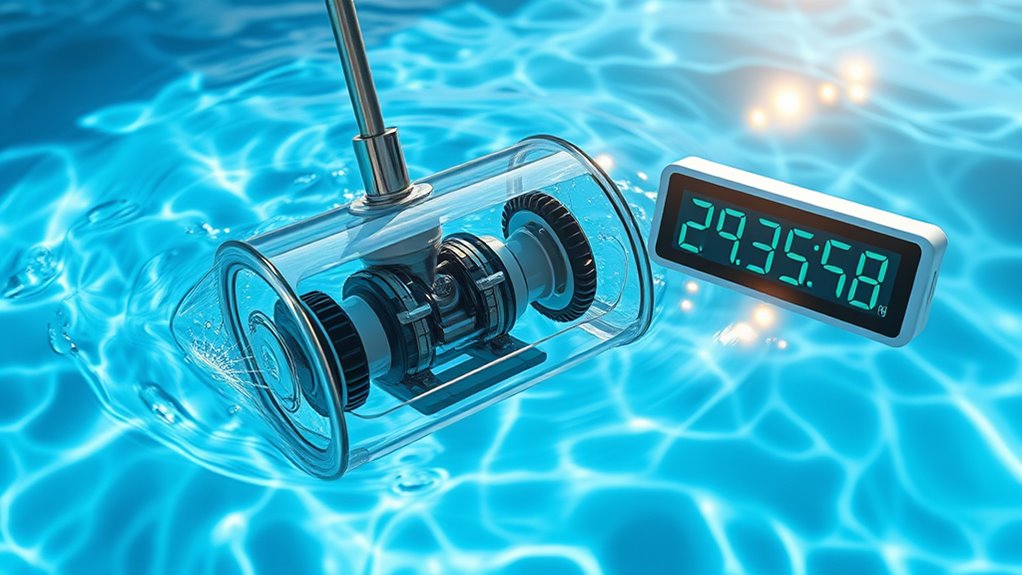
Your pool cleaner’s power efficiency directly affects your long-term energy bills. Choosing a model with lower energy use can save you money over time. Understanding these operational costs helps you make smarter, cost-effective decisions. Additionally, selecting a high-efficiency model can further reduce energy consumption and extend the lifespan of your equipment. Being aware of energy consumption patterns can help you optimize your pool maintenance routines for greater savings. Modern heat pump technology can also contribute to more energy-efficient pool heating, complementing your cleaner’s operation and overall energy savings.
Power Usage Efficiency
Considering energy consumption is essential when choosing a suction pool cleaner, as it directly impacts operational costs over time. Power usage efficiency varies widely among models, affecting both energy bills and device longevity. A cleaner with high battery life reduces the need for frequent recharges, saving you money and time. Additionally, a quieter unit minimizes noise pollution during operation. Understanding energy efficiency is crucial for making an informed purchase decision and optimizing long-term savings. Moreover, selecting an energy-efficient model can contribute to environmental sustainability by reducing electricity usage. It’s also helpful to compare models based on their power consumption to ensure you select a unit that balances performance and energy use. Here’s a quick overview:
| Model | Battery Life | Noise Level | Power Consumption |
|---|---|---|---|
| Model A | 2 hours | Moderate | Low |
| Model B | 3 hours | Quiet | Moderate |
| Model C | 1.5 hours | Loud | High |
| Model D | 4 hours | Very Quiet | Very Low |
| Model E | 2.5 hours | Quiet | Moderate |
Incorporating models with energy-efficient motors can further enhance overall efficiency and reduce operational costs.
Long-term Expense Impact
Long-term expenses for a suction pool cleaner are heavily influenced by its energy consumption and operational costs. While initial prices vary, ongoing electricity bills can add up over time, especially if the cleaner runs frequently. Customer reviews often highlight how energy-efficient models save money in the long run, making them a smarter investment. Additionally, the brand’s reputation plays a key role; trusted brands typically design more durable and efficient cleaners that consume less power, reducing ongoing costs. Some models may have higher upfront costs but lower operational expenses, making them more cost-effective over years of use. By considering customer feedback and brand reliability, you can better predict the true long-term expense impact, ensuring your pool cleaner remains affordable beyond its purchase price. Energy efficiency features can significantly reduce operational costs and contribute to long-term savings. A well-designed, efficient motor, for example, can further enhance energy savings and reduce wear and tear, prolonging the cleaner’s lifespan. Moreover, choosing models with low power consumption can lead to noticeable savings on your electricity bill over the years.
Maintenance, Repairs, and Part Replacements
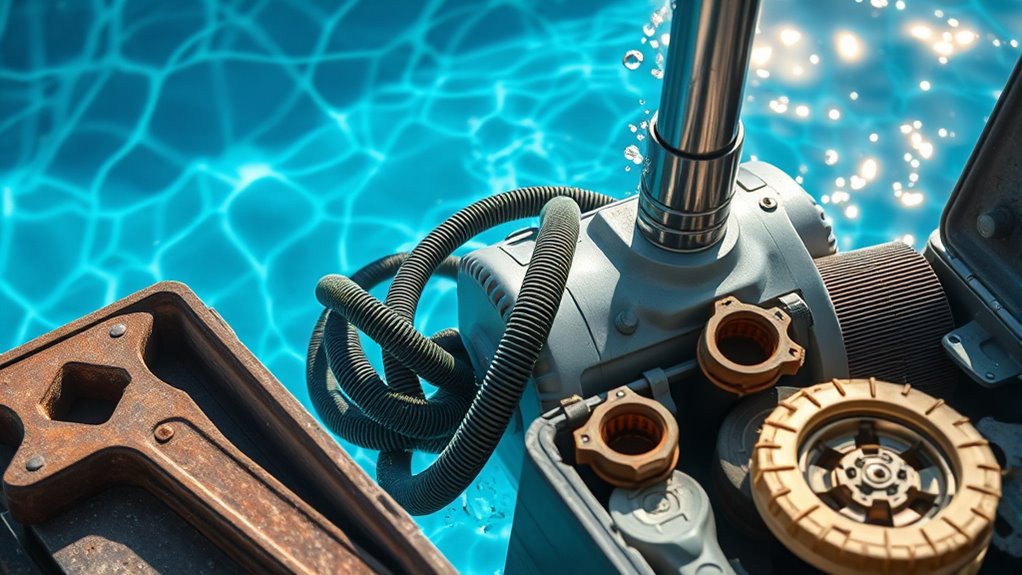
Regular maintenance and timely repairs are essential to keep your suction pool cleaner functioning efficiently. You should regularly check the pool surface for debris and ensure the cleaner’s brushes and skirts are in good condition. Replacing worn-out parts prevents dirt and debris from bypassing the cleaner, maintaining ideal water filtration. Keep an eye on hoses and seals for leaks or cracks, as damaged parts can reduce suction power. Cleaning the filters and removing blockages helps sustain proper water flow and energy efficiency. When parts wear out, replacing them promptly minimizes downtime and prevents further damage. Proper upkeep ensures your cleaner operates smoothly, extends its lifespan, and keeps your pool water clean and clear without unexpected costs. Additionally, inspecting the self-watering system components regularly can help prevent over- or under-watering of your plants. Regularly checking filter performance can also improve the overall efficiency of your pool cleaning system. Staying informed about smart home technologies can further enhance your pool maintenance routines and overall home efficiency. Moreover, understanding the importance of proper placement can optimize the cleaner’s effectiveness and reduce operational issues. Incorporating sound design principles, such as assessing the acoustic environment, can help identify unusual noises indicating mechanical issues that require attention.
Impact on Pool Equipment and Water Chemistry

A well-maintained suction pool cleaner can positively impact your pool equipment and water chemistry by ensuring efficient operation and preventing issues. When it functions properly, it reduces debris buildup and minimizes filter fouling, keeping your pump and filter system from overworking. However, if it’s neglected, debris can clog the filter, leading to decreased water flow and chemical imbalances. This can cause algae growth and cloudy water. Regularly checking and cleaning the cleaner helps keep debris moving smoothly, protecting your equipment and maintaining balanced water chemistry. Additionally, analytical cookies can help monitor the effectiveness of your pool maintenance routines, ensuring optimal water quality. Proper use of eye patches in routine maintenance can also assist in identifying potential issues early before they impact water balance. To further support your pool care, understanding the importance of filter performance is essential for maintaining a healthy swimming environment.
Long-term Durability and Lifespan Factors
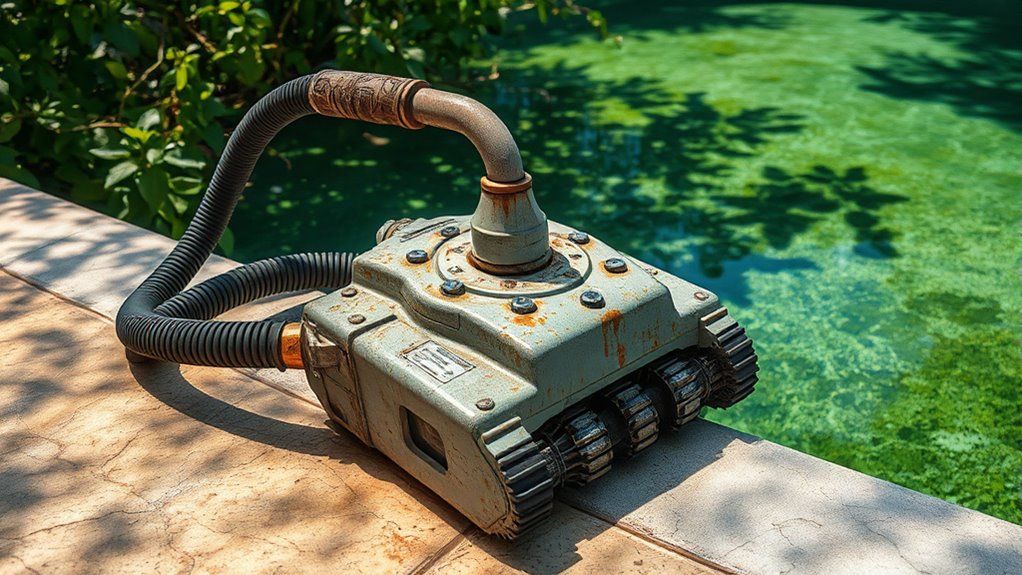
Proper maintenance of your suction pool cleaner not only keeps it functioning efficiently but also extends its overall lifespan. To guarantee durability, look for models with high abrasion resistance, which helps the parts withstand constant contact with rough surfaces and debris. Additionally, corrosion resistance is vital, especially since pool environments expose equipment to water and chemicals that can cause rust and deterioration. Regularly inspect and clean the brushes, hoses, and seals to prevent premature wear. Using quality materials designed for long-term use will reduce the frequency of repairs or replacements. Investing in a cleaner built with durable, corrosion-resistant components means you’ll get more years out of your device, ultimately saving you money and hassle in the long run.
Hidden Costs and Unexpected Expenses

You might find that maintenance and repairs add unexpected costs over time. Replacing parts can also catch you off guard and quickly increase your overall expenses. Being aware of these hidden costs helps you better plan your budget for a suction pool cleaner.
Maintenance and Repairs
Maintenance and repairs can introduce hidden costs that catch many pool owners off guard. While warranty coverage can help protect you from unexpected expenses, it often requires proper user training to ensure you’re addressing issues correctly. If you’re not familiar with the cleaner’s mechanics, you might misdiagnose problems or fail to perform necessary maintenance, leading to costly repairs down the line. Regular cleaning of filters and checking hoses prevent minor issues from escalating. Additionally, understanding the terms of your warranty can save you money, but only if you follow the guidelines for maintenance and repairs. Neglecting these responsibilities can void coverage or result in more frequent repairs, increasing your overall costs beyond the initial purchase price. Proper upkeep is essential to keep your suction pool cleaner running efficiently and cost-effectively.
Replacement Parts Costs
While replacing parts of a suction pool cleaner might seem straightforward, hidden costs can catch you off guard. Pricing fluctuations mean that part prices can vary unexpectedly, making budgeting difficult. You might find that a replacement nozzle or belt costs more than initially anticipated, especially if demand spikes or supply chain issues occur. Additionally, accessory compatibility issues can add to your expenses; not all replacement parts fit every model, forcing you to buy specific or more expensive options. Sometimes, you’ll need to replace multiple parts at once to keep your cleaner functioning properly, which can quickly add up. Before purchasing, verify that parts are compatible with your model and stay aware of fluctuating prices to avoid surprise expenses that can inflate your overall maintenance costs.
Frequently Asked Questions
How Does Suction Pool Cleaner Efficiency Vary With Pool Size?
You’ll find that your pool size directly impacts cleaner efficiency. Larger pools require more time and effort for your suction pool cleaner to cover all areas thoroughly, which can reduce efficiency. Smaller pools allow the cleaner to work more effectively and quickly, often leading to better cleaning results. So, understanding your pool size helps you choose the right cleaner and optimize its performance, ensuring your pool stays clean with less hassle.
Are There Environmental Impacts From Chemical Use Due to Cleaner Debris Collection?
Did you know that improper chemical use can lead to significant environmental impacts? When your suction pool cleaner gathers debris, it may cause chemical runoff into local water systems, harming aquatic life. Additionally, plastic waste from filter cartridges adds to pollution. By minimizing chemical use and recycling filter parts, you reduce your ecological footprint, helping protect the environment from chemical runoff and plastic waste linked to pool maintenance.
What Safety Precautions Should Be Taken During Installation and Maintenance?
When installing and maintaining your suction pool cleaner, you should prioritize electrical safety by guaranteeing all power sources are unplugged before starting. Always practice proper handling of the device’s parts and tools to avoid injury or damage. Follow manufacturer instructions carefully, wear protective gear if necessary, and keep the area dry to prevent electrical hazards. Regularly inspect cords and connections for wear or damage to ensure safe operation.
How Often Should Filters and Brushes Be Replaced for Optimal Performance?
You should check your filter maintenance regularly and follow a strict replacement schedule to keep your suction pool cleaner working effectively. Typically, replace filters every 2-4 weeks, depending on usage and water conditions. Brushes usually need replacement every 2-3 months to ensure peak cleaning performance. Staying on top of this schedule prevents clogs and damage, saving you money and extending your cleaner’s lifespan.
Can a Suction Pool Cleaner Be Used in Saltwater Pools Without Damage?
You might wonder if a suction pool cleaner can handle saltwater pools without damage. The truth is, many are compatible if you check the manufacturer’s guidelines. Saltwater pools use chlorine alternatives, which can affect pool chemistry and equipment longevity. Confirm your cleaner is rated for saltwater, and regularly monitor pool chemistry to prevent corrosion. Proper maintenance keeps your suction cleaner working efficiently, saving you money in the long run.
Conclusion
Understanding the true cost of owning a suction pool cleaner reveals more than just the upfront price. On average, these devices can add $300 to $500 annually in energy, maintenance, and repairs. Did you know that improper water chemistry caused by a cleaner’s use can increase chemical costs by up to 20%? Being aware of these hidden expenses helps you make smarter decisions, ensuring your pool stays pristine without unexpected financial surprises down the line.
